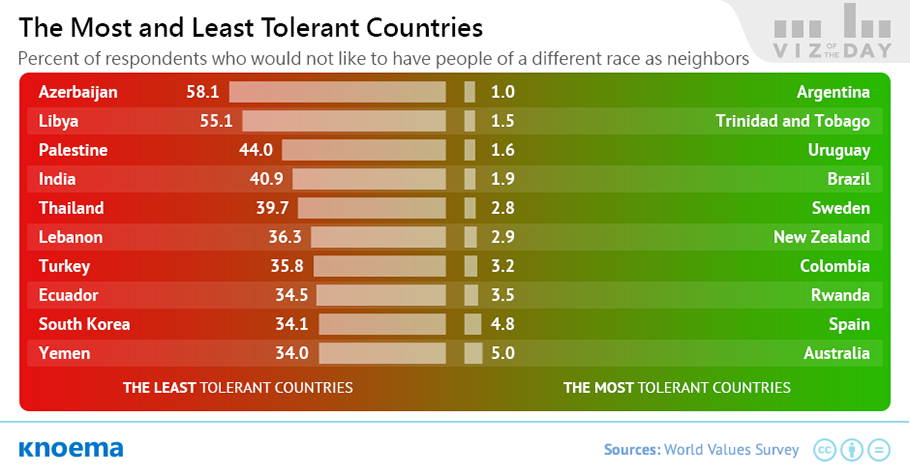The World Values Survey (WVS) examines the changing values of societies and the impact of these changes on social and political life. The WVS is composed of nationally representative surveys conducted in almost 100 countries that represent almost 90 percent of the world’s population. Initiated in 1981, the WVS is the largest non-commercial, cross-national, time series investigation of human beliefs and values ever executed. The survey repository includes interviews with almost 400,000 respondents, covering all of the world’s major cultural zones.
Among the dozens of questions that World Values asks is one about tolerance for other races. World Values asked respondents in more than 80 countries to identify the kinds of people they would not want as neighbors. Some respondents, picking from a list, chose "people of a different race." The more frequently that people in a given country gave that response, the less racially tolerant the society is rated.
Quick Facts:
- Anglo and Latin countries most tolerant. People in the survey were most likely to embrace a racially diverse neighbor in the United Kingdom and its former colonies (Australia, Canada, New Zealand, and the US) and in Latin America.
- Wide variation across Europe. Immigration and national identity are pervasive, sensitive issues in much of Europe, where the racial make-up is changing.
- Racial tolerance low in diverse Asian countries. Nations such as the Philippines, where many racial groups often jockey for influence and have complicated histories with one another, showed more skepticism of diversity.
- Pakistan, remarkably tolerant, an outlier. Although Pakistan has a number of factors that coincide with racial intolerance – sectarian violence, its location in the least-tolerant region of the world, and low economic and human development indices – only 15 percent of Pakistanis objected to a neighbor of a different race.
Материалы по теме
The Social Progress Index
The Social Progress Index is the result of a two-year process guided by a stellar team of experts which includes, among the others, renowned economists Hernando de Soto and Michael Porter and the president of The Rockefeller Foundation Dr. Judith Rodin. The Index synthesizes a huge body of research to identify the dimensions of performance of societies and measure the social progress comprehensively and rigorously. The Index has been structured around 12 components and 54 distinct indicators consolidated into three dimensions of Social Progress: Basic Human Needs, Foundations of Wellbeing, and Opportunity. The first dimension, Basic...
Aging Society as an Agent of Economic Change in India
People are living longer and, in some parts of the world, healthier lives. This represents one of the crowning achievements of the last century but also a significant challenge. Longer lives must be planned for. Societal aging may affect economic growth and many other issues, including the sustainability of families, the ability of states and communities to provide resources for older citizens, and international relations. Preparing financially for longer lives and finding ways to reduce aging-related disability should become national and global priorities. Experience shows that for nations, as for individuals, it is critical to address...
Happiness and economic well-being
According to the latest World Happiness Report, issued by the Sustainable Development Solutions Network (SDSN) on Apr 23 2015, the happiest countries in the world are Switzerland, Iceland, Denmark and Norway. Four top countries have average scores between 7.5 and 7.6, and the differences between them are not statistically significant. The rest of the top 10 (in order) are Canada, Finland, Netherlands, Sweden, New Zealand and Australia, all with average scores above 7.28. Comparing the country rankings in World Happiness Report 2015 with those in World Happiness Report 2013, there is a combination of consistency and change. Nine of the top...
Did the World Become Safer in 2016?
News headlines around the world inundate us with stories about terrorism, conflict, social unrest, plane crashes, natural disasters, global economic crises and more, always more. One might even think that 2016 was the worst year ever for humanity. But, was it? At Knoema, we let the data speak for itself. We have collected the most frequently updated and the most up-to-date statistics from reliable sources to take a practical view of the state of the world and how it has changed over the last year. By at least some measures, the world ended 2016 better than it ended 2015, with at least one notable exception. Pakistan. We do not yet know...
